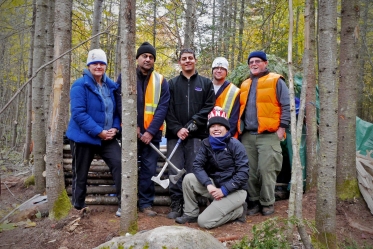
Two third-year students at FNTI's Aviation program recently completed a multi-day survival training course. Students Alex Grogan (pictured above in black jacket) and Jordon Farrell (above in white hat and organce vest) joined other survival students, including group leader Paddy Mercer (top right), a retired Search and Rescue Technician, for intensive session in a remote area near North Bay.
Jo-Anne Tabobandung, FNTI's Chief Flight Instructor says survival training is a standard part of aviation education. "Although aircraft accidents are a reality in aviation, the chance of survival is greatly increased with proper training."
The group put survival strategies first learned in a classroom into practice on-the-ground, including food and water collection and shelter construction.
Jodon says the most important thing he learned from the survival trip was "being able to modify what you learned in the classroom when you get out in the field. When we built the shelter we had to modify what we learned a lot since you can't get trees in the perfect places."
Another important lesson, he reports, is learning how to manage your time and energy. "I tend to work too hard at the start and fall off after. I learned quickly when I was chopping wood that I had to pace myself since we had all day to get fire wood. Without a watch too you can lose time very easily. You could be out working and the sun could start setting then you have to try and get a fire going in near-dark conditions."
Alex says the group went for a hike in the woods where "Paddy showed us different plants and a couple of traps that he had setup. he showed a moss called reindeer moss and a plant called lichen. These plants can be used as bedding and are edible."
The best part of the experience for him was the time spend creating and demonstrating signal fires and flares. "The smoke it produced was so thick you couldn't see more than 10 feet in front of you. The flares were so bright when they reached altitude it was hard to look in the vicinity of them. It helped me realize what they would look like from the air and what I would do to help out if I was flying and saw them."




